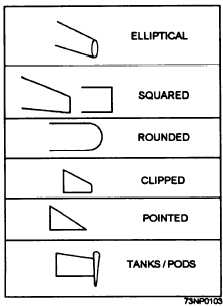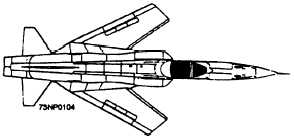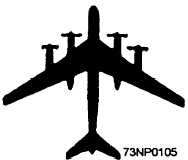Figure 13-5.—Wingtip shapes
Engine Criteria
The methods of determining engine type (jet or
prop) were previously discussed under Aircraft Types.
Identification of the type, number, and location of
engines, used in conjunction with two keys, will help
you identify aircraft. For example, the Soviet TU-95
BEAR is the only turboprop-powered heavy bomber
in the world. The wing mounts four turboprop engines
with coaxial, contrarotating propellers. As shown in
figure 13-7, all of the engine nacelles protrude forward
of the wing, but only the inboard engines have landing
gear nacelles that extend aft of the wing.
Figure 13-6.—Ultraforward-swept wing.
Figure 13-7.—Silhouette of the TU-95 BEAR
Fuselage Types
Use of the fuselage in aircraft recognition is
primarily restricted to its size and shape (fig. 13-8)
and the shape of the nose section (fig. 13-9). Nose
sections may also be glazed or have a shock cone.
In some jet models, the air intake may be located if
the imagery is of satisfactory quality. Seaplanes
have very distinct features in their fuselage design,
but such design characteristics are often difficult to
determine on vertical imagery. Shadows can be of
great help in this regard.
Tail Surfaces
Recognition characteristics of tail surfaces are
generally the shape and location of the horizontal
stabilizer, since the vertical stabilizer is difficult to
analyze in vertical imagery. The basic features
recognizable in the horizontal stabilizer are very
similar to those used for identifying wing surfaces:
shapes and tip shapes.
Another feature that can be of help is the
position of the horizontal stabilizer. For example,
the horizontal stabilizer may be located (1) on the
axis (centerline) of the fuselage, (2) below the
centerline, (3) above the centerline, or (4) on the
vertical stabilizer, above the fuselage. (See fig.
13-10.)
HELICOPTER IDENTIFICATION
Helicopters are among the most easily
recognizable military equipment. The term rotary-
wing aircraft includes those aircraft that depend
primarily on lift from their rotary-propulsion
systems. Also, the maneuverability and the forward
thrust are controlled either by the rotor system or by
an auxiliary engine system. For our discussion,
aircraft meeting this criteria are called helicopters.
The primary recognition features used in
helicopter identification are the rotor system and
the number of rotor blades (never less than two).
After determining the type of rotor system and the
number of blades, you should refer to the
appropriate aircraft book for final determination
of the model. Military Aircraft of the World is a
good source.
Other factors that will assist you in helicopter
identification are the shapes of the fuselage and
tail boom and the presence or absence of wings.
13-3





